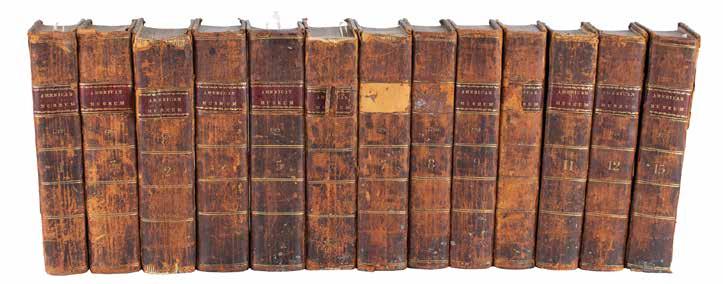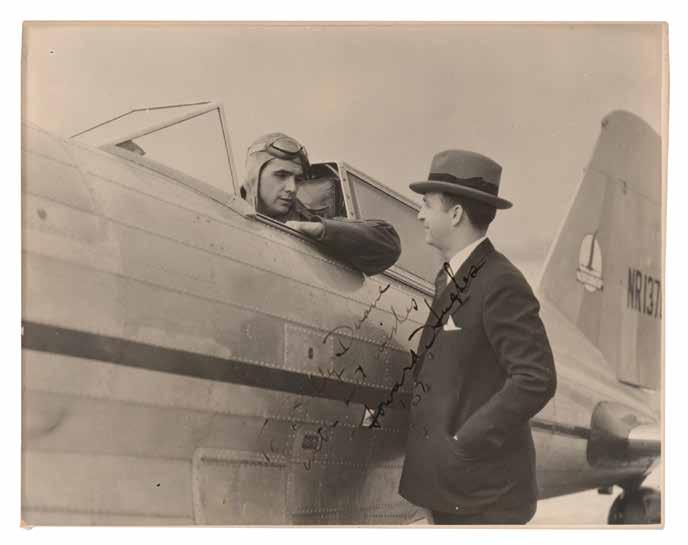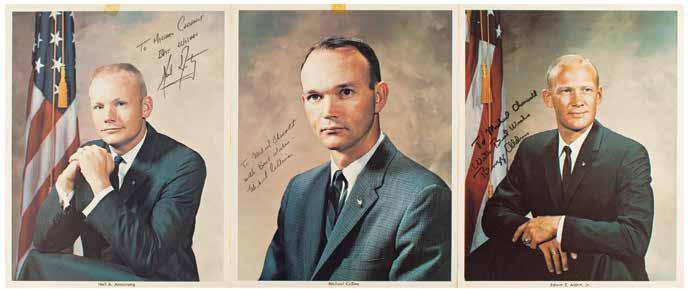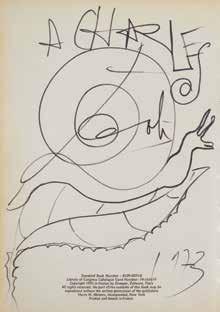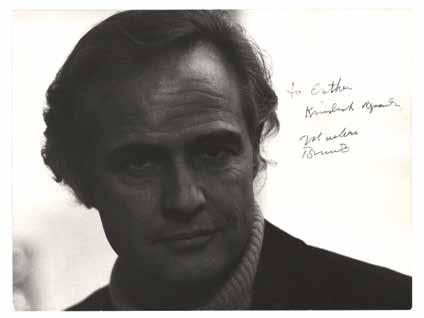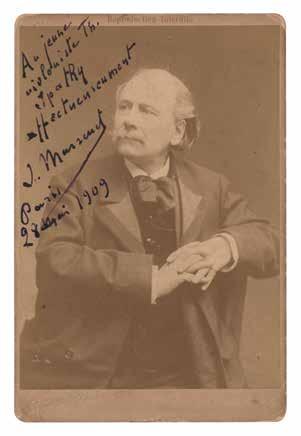
27 minute read
Notables
Declaration of Independence
1. Joseph Hewes Document Signed. Secretary of the Naval Affairs Committee during the Revolutionary War (1730–1779) who signed the Declaration of Independence, one of only three Quakers to do so. Revolutionary War–dated manuscript DS, one page, 8 x 11.5, August 10, 1777. Document from Chowan County, North Carolina, in part: “Know all men by these presents that Benjamin Joy, Joseph Hewes, and Arch Corry all of the County and State afor’d are held and stand…bound unto Evan Skinner High Sheriff of the County afor’d in the full…sum of one thousand pounds to the which payment will and truly to be made and done like bind ones selves and heirs and Exect. Administrators and signors family by these Presents Sealed with our Seal, and dated the 10th Day of August 1777.” Docketed on the reverse by Skinner: “I Evan Skinner Sheriff of Chowan County do hereby assign the within obligation and condition to William Cumming the plaintiff therein named…and administrators to be sued for according to the statute in such care made and provided in. Witness Whereof I have hereto set me hand and seal this 22nd day of October 1778, Evan Skinner Sheriff.” In very good to fine condition, with some scattered stains, and professional repairs to areas of ink erosion.
Born in New Jersey, Hewes had settled down in North Carolina in 1760 and was subsequently elected to the state legislature in 1763. When he was made Secretary of the Naval Affairs Committee in 1776, he found the fledgling American Navy in a poor state and, as a successful merchant, was able to provide his own extensive fleet of ships and outfit them for battle. He also selected the most capable men as commanders, including the great John Paul Jones. Afflicted with ailing health, Hewes had to return home shortly after signing the Declaration of Independence and passed away in 1779 at just 49 years old. Hewes’s untimely death has made his autograph especially scarce, and he is considered among the ‘very rare’ signers of the Declaration. Starting Bid $300
Envelope addressed to a fellow signer of the Declaration of Independence
2. Richard Henry Lee Hand-Addressed Mailing
Envelope. Very desirable hand-addressed mailing envelope, measures 6 x 8 unfolded, signed in the lower left, “R. H. Lee,” and addressed to his fellow Declaration signer from Pennsylvania, “Honorable Robert Morris Esq’r, Member of Congress at Philadelphia.” In very good condition, with creasing, tears, and separations, repaired and reinforced on the back with old tape. Starting Bid $200
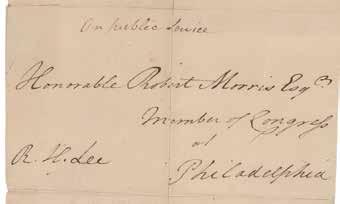
Rush forwards a respectful letter by Benjamin Franklin to a patriot’s widow
3. Benjamin Rush Autograph Letter Signed. Signer of the Declaration of Independence and surgeon general of the Continental Army (1746–1813). ALS signed “Benj’n Rush,” one page, 8 x 9.75, August 9, [no year]. Letter to Rebecca Archer, the widow of Capt. Henry Waldegrave Archer. In part: “In looking over a number of letters from Dr. Franklin, I met with the enclosed, in which your deceased husband’s name is mentioned with great respect. Recollecting the affection you bore him, and the tenderness with which you nursed him during the long and distressing illness which preceded his death, I presumed the perusal and possession of a letter which does him both justice and humor could not fail of being acceptable to you.” A pencil notation to the address leaf notes that the enclosed letter was dated June 17, 1778. In very good condition, with scattered staining, areas of seal-related paper loss, and complete separation from its integral address leaf (which is still present).
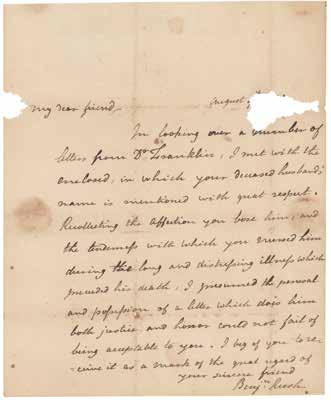
In 1778, Henry Waldegrave Archer made application to Benjamin Franklin in Paris, hoping to join the American cavalry in the revolutionary cause. He explained: ‘I want to join the American Army and become a citizen. Although I am an Englishman I did not enter the King’s army, because it would have meant fighting my conscience; that army will probably become the instrument of despotism. In the United States, on the contrary, the disciplined soldier and the free citizen are compatible.’ Franklin then recommended Archer to Rush in a letter of June 17th, introducing him as ‘a young Gentleman of excellent Character,’ and recognizing his ‘Zeal for the Cause of Liberty, and strong Desire of being serviceable to it and to our Country.’ It was this letter that Rush would later send to Rebecca Archer, his widow. Starting Bid $300
South Carolina’s governor submits to the state legislature

4. Edward Rutledge Autograph Letter Signed. American politician from South Carolina who was the youngest signer of the Declaration of Independence (1749–1800). ALS, one page, 7 x 4.5, December 7, 1799. As governor of South Carolina, Rutledge informs the legislature of the resignation of the state’s engineer. In full: “Mr. President & Gentlemen of the Senate: Honorable Gentlemen, I herewith transmit to you a copy of a letter, which I received from Colonel Serf, containing his resignation, as Engineer of this State.” Double-matted and framed with an engraved portrait and plaque to an overall size of 13 x 20; the frame’s backing has a window for viewing the docketing on the reverse. In fine, clean condition. Starting Bid $200
The rare New Hampshire signer orders an arrest: “Bring him to me...to be Dealt with as the Law Directs”
5. Matthew Thornton Autograph Document Signed. Signer of the Declaration of Independence from New Hampshire (1714–1803). Partial ADS, signed “Matthew Thornton, Just. of Peace,” one page trimmed to 7.5 x 5.75, September 6, 1765. A warrant wherein Thornton orders the apprehension of Arthur Archibald “(if he may be found in your precinct) & bring him to me, to be Examined Touching the Premises, & to be Dealt with as the Law Directs.” A remnant of the wax seal remains at upper left. Matted and framed with a portrait and engraved plaque to an overall size of 18 x 12.5. In very good condition, with scattered soiling and wrinkling, and a small hole touching the paraph. The signature itself is clear, dark, and otherwise unaffected. In his 1995 reference History Comes to Life, Kenneth Rendell places Thornton’s autograph material into the ‘rare’ category among the Signers. Starting Bid $200

American Politicians and Leaders
7. Colonial Massachusetts and Mayflower Descendants Documents. Collection of ten documents from early colonists and Mayflower colony descendants, dated from the mid-1600s to mid-1700s, with associated names including Winslow, Tyler, Ballantine, Bosworth, Holbrook, Gray, Thomas, Peabody, and Gould. Includes: Samuel Bosworth (DS, March 18, 1668); John Winslow and Isaac Winslow (DSs, December 10 and 20, 1672); Elizabeth Williams (DS, September 8, 1691); Isaac Winslow (Plymouth, MA, March 1722); Edward Winslow and John Ballantine (DS, September 23, 1723); Edward Winslow and John Ballantine (DS, October 7, 1717); Nathaniel Winslow (DS, July 1705); Richard Peabody (January 9, 1764); S. Tyler (DS, August 13, 1728, pertaining to Wrentham, Bellingham, Holbrook, etc., and mentioning John and Peter Holbrook). In overall very good to fine condition. Starting Bid $200
Native Americans on Martha’s Vineyard sell land to a colonist in 1704
8. Native American: Martha’s Vineyard Land Deed. Manuscript DS, one page, 7.75 x 12, December 20, 1704. Incredibly rare deed signed by Native Americans from the Tackanash family, recording the sale of “a place commonly known by the native name of Paquay Neck lying at the southern point of said neck,” from Joshua Tackanash, Isaac Tuhkimmy, and Elihu Tickknish to Samuel Smith of Edgartown, Martha’s Vineyard. The signatures of the Native American sellers Isaac and Joshua are scribed symbols, Elihu writes his own name, and the left margin is signed by Joseph Norton. Docketed and signed on the reverse by Mathew Mayhew. In very good condition, with edge tears, paper loss, and some light staining.
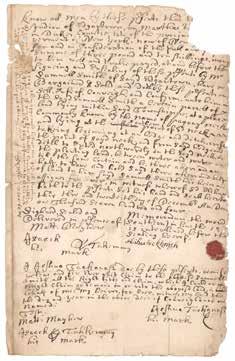
John Tackanash is mentioned in Experience Mayhew’s Indian Converts, an account of the Christianized Indians of Martha’s Vineyard. Tackanash was ordained by Hiacoomers in 1670, and was a capable pastor on the island. It seems likely that he gave his children the biblical names of Elihu, and Joshua. The location in question is adjacent to Paqua Pond in Edgartown. Starting Bid $200
Rare Indian land deed from 1684— colonists buy property on Cape Cod
9. Native American: Cape Cod Land Deed. Manuscript DS, one page, 15 x 11.5, June 9, 1684. Original deed for the sale of Indian chief Joseph Sepit’s land in New Plymouth to Elisha Bourne for one pound and one half sterling. Signed with famous Native American chief Joseph Sepit’s ‘turtle’ pictograph and countersigned by William Bassit, Edward Stewart, and Runanna Bourne. Affixed to a larger scrapbook page with old catalog listing below. In very good to fine condition, with scattered toning, paper loss to the lower right edge, and old repairs to the back of the right edge. To reach Cape Cod today, one must drive over the Bourne Bridge to arrive in the town of Bourne. A splendid item of great rarity. Starting Bid $500
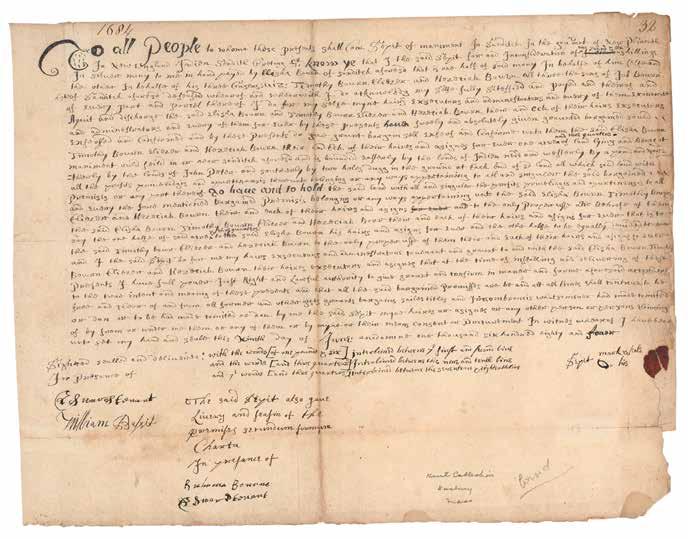
Summary of the Law of Nations, from the library of Washington’s first Attorney General and later Secretary of State
10. Edmund Randolph Signed and Personally-
Owned ‘Law of Nations’ Book. American politician (1753–1813) who served as both attorney general and secretary of state in George Washington’s cabinet. Signed book: Summary of the Law of Nations, Founded on the Treaties and Customs of the Modern Nations of Europe, by Georg Friedrich von Martens. First American edition. Philadelphia: Thomas Bradford, 1795. Leatherbound hardcover, 5.25 x 8.5, 379 pages. Signed on the title page in ink with his ownership signature, “Edm. Randolph.” Interestingly, the text is prefaced by the publisher’s dedication to George Washington. The last pages of the book contain a list of subscribers, including Randolph himself, Aaron Burr, James Madison, and other notable political figures of the era. Autographic condition: very good to fine, with toning to the edges of the signed page. Book condition: VG-/None, with rubbing and scuffing to boards, and light foxing and toning to textblock. An 1826 Randolph family manuscript receipt for “instruction in both the French and Spanish languages” is loosely laid in, evidently used as a bookmark. An intriguing work on international law and politics from the personal library of one of America’s distinguished early statesmen. Starting Bid $300
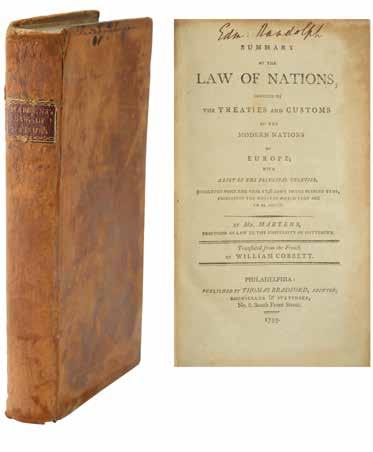
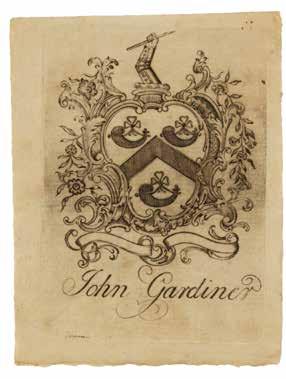
Rare bookplate engraved by Paul Revere
Rare original bookplate engraved by Paul Revere for John Gardiner of Gardiner’s Island, 3.25 x 4.25, featuring his coat of arms: the image features a heavily decorated Chippendale-style border with mantling, leaves, and flowers surrounding a crest. The central image features three powder horns with clovers divided by a chevron. At the helm is a bent arm in armor with a bare hand holding what appears to be a quill. In fine condition. Accompanied by a limited edition book entitled “Paul Revere’s Bookplate for John Gardiner of Gardiner’s Island,” published by Boss Books in 2013, which briefly describes the history of these bookplates and notes that about 40 are known; it also features tipped in reproductions of several Revere bookplates. Also includes Paul Revere’s Engravings by Clarence S. Brigham, published by the American Antiquarian Society in 1954, signed and inscribed on the first free end page by Brigham; the large volume offers a short discussion of Revere’s bookplates within the context of his broader engraving work. Starting Bid $200
12. Stephen A. Douglas. Eminent American senator and statesman (1813-1861), dubbed the ‘Little Giant,’ perhaps best remembered for his role in the Lincoln-Douglas debates during the 1858 campaign for the Senate race in Illinois. ALS signed “S. A. Douglas,” one page, 7.75 x 9.75, December 3, 1854. Letter to Sidney Webster, who had been the private White House secretary to President Franklin Pierce. In part: “The protracted illness of Mrs. Douglas, and myself, will account for the delay in acknowledging the receipt of your very kind letter. I have read the slip which you enclosed, and have seen several other articles, to the same effect, which I have no doubt received the sanction of Gen. Pierce,before their publication.” In fine condition, with faint toning along the horizontal folds. Starting Bid $200

Activists and Social Leaders
On Suffrage letterhead, Anthony confirms a speech at a New Orleans “Womens Club” with “Miss May Wright Sewall”
13. Susan B. Anthony Autograph
Letter Signed. ALS, three pages on two adjoining sheets, 5.5 x 8.5, National Woman Suffrage Association letterhead, March 7, 1885. Written from New Orleans, a letter to Ms. Underwood, concerning a reimbursement, in part: “I am overwhelmed with the amount enclosed...You ought to have deducted the $12...but since whatever owed to me is surely going with suffrage work, it is only taking from part of the vineyard & giving it another.” Anthony adds her initials “S.B.A” to the close of a postscript, “I shall stay here until about the 20th inst, am invited to speak before the ‘Womens Club’ of this city next Monday evening—Miss May Wright Sewall also.” In fine condition. Starting Bid $200


14. Malcolm X Autograph Letter Signed. ALS signed “Salaam Alaikum, Malcolm X,” two pages, 8.25 x 10, August 9, 1964. Letter to Earl Grant (“My Dear Brother Earl”), written from Cairo, shortly after his pilgrimage to Mecca. In part: “I arrived back here in Cairo last night...Everyone here has been fine to me, and I can say without reservation that if the Afro Americans get any support in our struggle for Human Rights, it will come from the Muslim World faster than from any other ‘block.’ Muslims have faults, but overall they are sincere and can be trusted farther than any other people, or any other form of government…

I’m writing a letter today to Bro. Charles 37 also. When I return I hope to have ‘names’ and ‘citizenship’ for all who accept True Islam. I know it seems to be taking a long time but good things always take a long time. At any rate, Allah is blessing me to make some progress, and being over here is another blessing because it makes it impossible for the enemy to blame me for all of the mess that is exploding over there in the States. The OAAU now has branches in Cairo UAR and Accra Ghana, and I will organize the Afro-American community in each country that I visit so they can help from over here, in our struggle for human rights. Help keep the believers in unity, because unity is the key to our success.” In fine condition. Starting Bid $1000
Businessmen
On the passing of his brother Bill, “a fine fellow”
15. Harley-Davidson: Walter Davidson Typed
Letter Signed. Engineer and business executive (1876–1942) who, along with his brothers William and Arthur and friend William Harley, founded the famed Harley-Davidson Motor Company in 1903 and served as its first president, a post he retained until his death. TLS, one page, 8.25 x 7.25, Harley-Davidson Motor Co. letterhead, May 19, 1937. Letter to Gene Walters, in full, “Thank you very much for your very kind letter of condolence for the passing of Bill Davidson. All you dealers who had the opportunity to meet Bill know what a fine fellow he was, and you can realize what a gap his passing is going to leave in our organization. Again thanking you for your very kind words.” In fine condition. Starting Bid $200

Scientists and Inventors
16. Thomas Edison Signature. Bold vintage pencil signature, “Thos. A. Edison,” on a white 3 x 2 card. In fine condition, with slight brushing to the pencil, a paperclip impression to the top edge, and old mounting remnants on the back. Accompanied by a modern unsigned photo of Edison in his lab. A prime example of Edison’s iconic ‘umbrella’ signature. Starting Bid $200

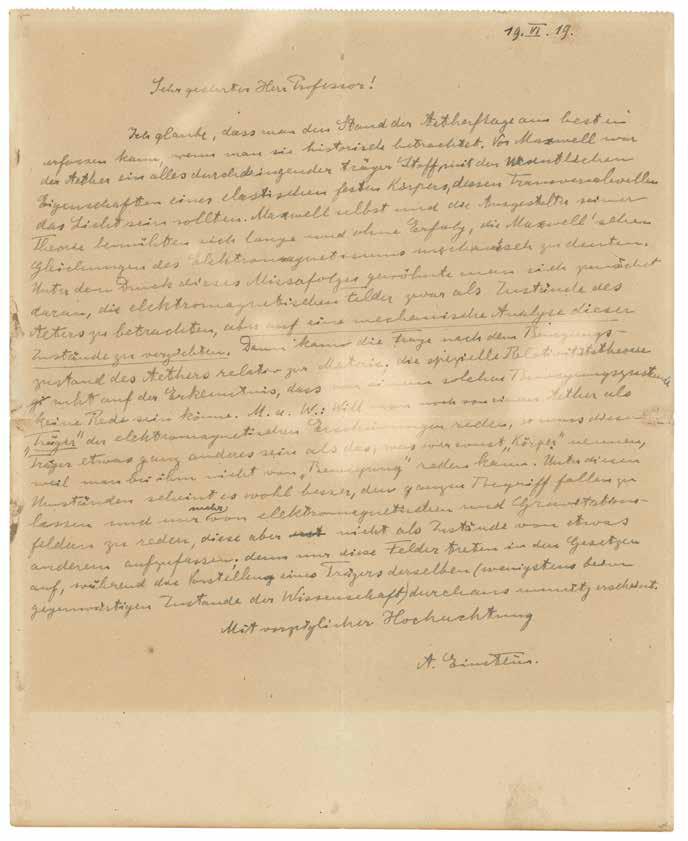
Unpublished and unknown to scholarship—Einstein reevaluates the ‘ether’ concept in an early 1919 letter, considering its implications for Relativity Theory
17. Albert Einstein Autograph Letter Signed on Ether. ALS in German, signed “A. Einstein,” one page, 8.75 x 10.75, June 19, 1919. Significant scientific letter documenting an early and critical stage of Einstein’s re-evaluation of the ether concept. Einstein here gives a substantive account of “the state of the ether question.” After first giving a brief historical overview of the ether, Einstein then considers its relationship to, and implications for, Relativity Theory: “The special theory of relativity is based on the knowledge that there can be no question of such a state of motion [of the ether],” Einstein here affirms. “If one wants to speak of ether as ‘carrying’ the electromagnetic phenomena, then this carrier has to be something completely different from what we otherwise call ‘body’, because one cannot speak of ‘movement’ with it. Under these circumstances it seems better to drop the whole concept and to speak more of electromagnetic and gravitational fields, but not to regard these as states of something else.” Einstein forcefully concludes that “only these [gravitational and electromagnetic] fields appear in the laws [of physics]”—tersely pointing at General Relativity as the necessary intellectual context in which the ether question is to be resolved. In very good to fine condition, with some staining to the edges, and overall irregular toning.
The present letter is a valuable and important addition to our knowledge of Einstein’s evolving view of the ether. Written at an early stage of Einstein’s re-evaluation of the ether concept—before any of his formal public statements on the ‘new ether’—the contents of this letter decidedly presage Einstein’s first public announcement of his views in 1920. Historians of science are now finding their way to this ‘ethereal’ aspect of Einstein’s thought, and the present letter is a newly discovered document of critical importance to the historical record. Starting Bid $5000
18. Albert Einstein Typed Letter Signed on God and Natural Selection. TLS signed “A. Einstein,” one page, 8.5 x 11, blindstamped personal letterhead, November 5, 1953. Letter to Lester Murphy in Brooklyn, in full: “Thank you for sending me your manuscript and the book by Lecomte de Nouy. I find the man interesting in what he tells about our knowledge in paleontology and his doubts about the opinion that natural selection has given a satisfactory explanation of the trend toward increasing organization and differentiation in the organic world. But I must confess that his arguments in favor of traditional religion with a planning God appear to me rather childishly anthropomorphic.” In very good to fine condition, with overall creasing, heaviest to the bottom blank area.

In 1947, biophysicist and philosopher Pierre Lecomte du Noüy published a book entitled Human Destiny, which used the lens of science to explore questions of existence: ‘Is there a God? What is the soul? Can man evolve any further—or has he reached a biological and spiritual dead-end?’ Here, Einstein writes that while some of du Noüy’s observations about evolution are intriguing, his arguments in favor of a “planning God” are childish and unscientific. Although he did not believe in a personal deity, Einstein was not averse to speaking of God in a scientific context. In 1929, Einstein said that he believed ‘in Spinoza’s God, who reveals himself in the harmony of all that exists,’ and in the 1950s wrote, ‘If something is in me which can be called religious then it is the unbounded admiration for the structure of the world so far as our science can reveal it.’ It was these harmonious structures—the things at the very core of creation—that Einstein hoped to uncover and describe in his quest for knowledge as a physicist, forming a bridge between the scientific and the spiritual. Starting Bid $2500
“Many thanks for the well done pictures”— Einstein to a photographer forced to flee Vienna by the Nazis in 1938

19. Albert Einstein Typed Letter Signed. TLS signed “A. Einstein,” one page, 8.5 x 10.5, blindstamped Princeton letterhead letterhead, April 23, 1945. Letter to artist and photographer Robert Haas in New York City, in full (translated): “Many thanks for the well done pictures. I have marked on the back side those which, in my opinion, are the best, and I would appreciate it if you would send me some of these.” In very good to fine condition, with multiple intersecting folds. Like Einstein, Haas had been compelled to flee Europe by the specter of World War II. Starting Bid $300

Arbitration in Fulton’s attempt to patent towing by steamboat

20. Robert Fulton Document Signed. Manuscript DS, one page both sides, 8 x 9.75, November 26, 1813. Power of attorney document associated with a patent arbitration case in Hartford, by which Fulton authorizes “John Devereux Delacy of the City of New York for me and on my part and behalf to appear, act, transact and do all matter and things whatsoever, and an award agree to and make in the above case as by the said patent law is or may be required.” Endorsed on the reverse by DeWitt Clinton, then the mayor of New York City. The affixed paper seal remains fully intact. In very good condition, with overall staining, and old repairs to the hinge and fold splits. The dispute with John Sullivan concerned Fulton’s request for a patent ‘for towing boats and warping them over rapids by means of their engines.’ Despite the competency of Delacy, the arbitrators at Hartford found in favor of Sullivan and denied the patent. Starting Bid $300
Important theological statement by Isaac Newton, embodying the core of his religious heresy and his belief that the Church had corrupted the true doctrine of Christ
21. Isaac Newton Handwritten Manuscript on Religion. Important handwritten religious manuscript by Isaac Newton, one page, 7.5 x 3, no date. Newton weighs in on a central tenet of Christianity, researching the origin of the doctrine of the trinity, writing in full: “The Council of Nice in decreeing the son to be ὁμοούσιος consubstantial to the father, understood that the father & son were two substances. For so the word ὁμοούσιος implies. But Hosius who (a - Athanas) published the Nicene Creed translated it unius substantiæ, & this translation gave occasion to some of the Latins to take the father & son for one single substance, & to the Greeks of this opinion to translate unius substantiæ by μιᾶς οὐσίας and μιᾶς ὑποστάσεως & to the western bishops in the Council of Serdica to declare that μίαν εἶναι ὑπόστασιν ῆν ἀντὸι ἀιρετικὸι οὐσίαν προσαγορεύουσιν, τοῦ πατρὸς καὶ τοῦ υἱοῦ καὶ τοῦ ἁγίου πνεύματος, that there is but one hypostasis of the father & son & holy Ghost.” In fine condition.
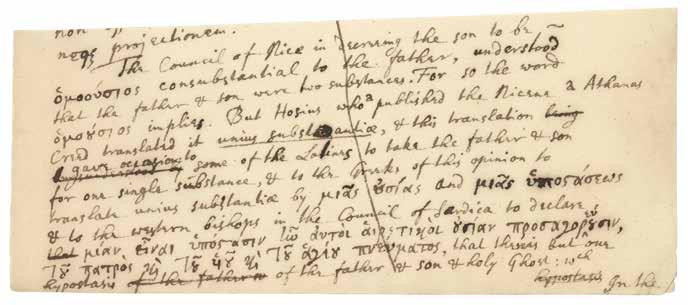
This significant autograph statement illuminates the core of Newton’s religious heresy. Newton held a view of the Trinity at variance with the Church of England—a heretical view punishable by death—and he here articulates the basis for his theological perspective. Newton believed that the ancient Church had corrupted the true doctrine of Christ, and the present document shows Newton demonstrating that the orthodox doctrine of the Trinity is based in a mistranslation of a key term of the Nicene Creed. The present document superbly testifies to Newton’s critical mind and philosophic acumen; its use of Greek writing is uncommon. A central document for our understanding of Newton’s view of God. Starting Bid $2500
Recently widowed, Morse sends supplies to his father in 1825
22. Samuel F. B. Morse Autograph Letter Signed. ALS signed “Your affectionate son, Sam. F. B. Morse,” one page, 7.75 x 9.5, March 19, 1825. Written from New York, a letter to his father, pastor and geographer Jedidiah Morse, in full: “On board the Packet Sloop Cornelia Capt. Hemmenway, (by which vessel I drop this line in case she arrives before my letter by the mail) you will find two barrels, five bottles cider, and two groce of velvet corks. Three parcels in all.” In very good to fine condition, with some light creasing and staining. Starting Bid $200

Atomic Energy for Military Purposes, signed by Manhattan Project scientists Oppenheimer, Fermi, Allison, Bainbridge, and Kistiakowsky
23. Robert Oppenheimer and Enrico Fermi Signed Book. Signed book: Atomic Energy for Military Purposes. First edition. Princeton, NJ: Princeton University Press, 1945. Hardcover, 5.75 x 8, 264 pages. Signed on the half-title page in fountain pen by Manhattan Project scientists J. Robert Oppenheimer, Enrico Fermi, Samuel K. Allison, Kenneth T. Bainbridge, and George B. Kistiakowsky. The first free end page is stamped with the name of Manhattan Project scientist Laurence Cherry, designer of the detonation system for the Fat Man bomb, and bears his ownership notation with return address. The page is also annotated, “Purchased 1946 at Los Alamos, N. Mex.” Autographic condition: fine. Book condition: VG/None, with some staining to boards, edgewear, and rubbing to spine ends. Accompanied by a matte-finish photo of housing at Los Alamos, and some copies of newspaper clippings. Starting Bid $300
24. Hans Christian Orsted Autograph Letter Signed. Danish physicist and chemist (1777–1851) who discovered that electric currents create magnetic fields, which was the first connection found between electricity and magnetism. ALS in French, signed “H. C. Orsted, Secretaire de la Societe Royale des Sciences a Copenhagen, Professeur de Physique, Chevailler de l’ordre de Dannebrogue,” one page, 8 x 9.75, March 19, 1816. Letter to the philosopher Maine de Biran, presenting a medal on behalf of the Royal Society of Copenhagen in recognition of his influential authorship of works on psychology and physiology. In fine condition. Starting Bid $200
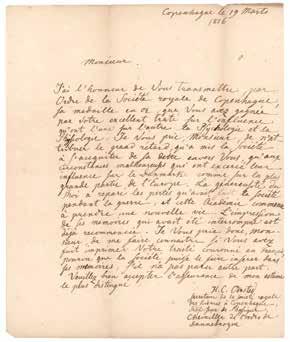
World Leaders

25. Winston Churchill Typed Letter Signed. TLS signed “Winston S. Churchill,” one page, 7.5 x 9.5, 28 Hyde Park Gate letterhead, December 8, 1949. Letter to Sir Richard Wells, in full: “Thank you for your letter of December 2 about the Grand Habitation of the Primrose League next April. I would suggest that Lord Salisbury should be asked to be the principal speaker on this occasion.” In fine condition, with light creasing to the lower blank area, and a rusty paperclip impression to the top edge. Founded in 1883, the Primrose League was established to spread conservative principles in Great Britain. A close friend of Churchill, Robert Gascoyne-Cecil, 5th Marquess of Salisbury, served in several political and cabinet positions over the years. Starting Bid $200
26. Winston Churchill Typed Letter Signed. TLS signed “Winston S. Churchill,” one page, 7.5 x 9.5, Hyde Park Gate letterhead, May 2, 1951. Letter to editor and publisher Desmond Flower, in full: “Thank you so much for your letter of April 26 and for sending me your cheque in respect of the new book of speeches, and the counterpart agreement, which I am glad to have. When do you think you will be able to publish?” In fine condition, with secretarial notations to lower left. Accompanied by Flowers’s response letter, dated May 11th. Starting Bid $200
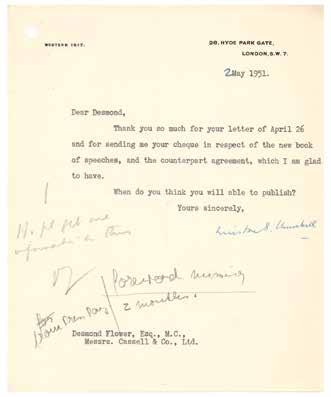
War-dated message from the leader of the Free French Forces: “All is well for the Navy and for France”
27. Charles de Gaulle Typed Letter Signed.
World War II-dated TLS in French, signed “C. De Gaulle,” one page, 8 x 10, personal letterhead, October 6, 1942. Letter to Captain Vaisseau Ortoli on board the Triumphant, in part (translated): “Your beautiful building will soon resume the sea. You know what friendship I have for you. So you follow I, one and the other, carefully in your travels, and I hope, in your battles.” In the upper left, de Gaulle adds a handwritten postscript: “All is well for the Navy and for France. We will take the case of one or the other if all are striving to the same cart. C. G.” In fine condition, with central horizontal and vertical folds. Starting Bid $300
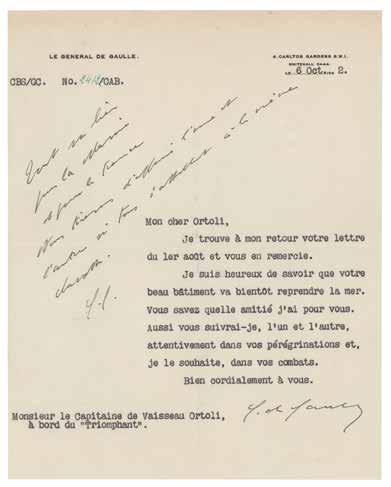

28. Honore Gabriel Riqueti, comte de Mirabeau Handwritten Manuscript. Controversial leader of the early stages of the French Revolution (1749–1791). Untranslated handwritten manuscript in French, unsigned, penned in the hand of Honoré Gabriel Riqueti, one page, both sides, 6.75 x 8.5, no date. One side appears to be the opening of an article entitled “Réflexions Sur La Musique en général et sur La Musique instrumentale en particulier” [Reflections on music in general and on instrumental music in particular]; the other side is marked “N’o 19” in the upper left corner. In very good to fine condition, with staining to the lower right corner, an old mounting strip along the left edge, and a numbering slip affixed to the upper left corner, which covers a small area of paper loss on the reverse. Starting Bid $200


29. Robert Semple Autograph Letter Signed. Governor of the Hudson’s Bay Company’s Red River Colony in Canada from 1815 until his death at the Seven Oaks massacre in June 1816. ALS signed “Rob’t Semple,” one page, 8 x 9.75, March 20, 1815. Letter to his uncle, in part: “I have directed the inclosed letter to your care and left it open for your perusal.” In very good condition, with creasing, toning, staining, some short edge tears, and red wax seal remnants to left side. Starting Bid $200
The ‘Big Three’
30. Truman, Churchill, and Stalin Signature
Display. Significant assemblage of ink signatures from the Grand Alliance leaders of late World War II—Harry S. Truman, Winston Churchill, and Joseph Stalin—penned on individual off-white slips ranging in size from 2.25 x .5 to 3.5 x .5. Matted together with a photo of the three men at the 1945 Potsdam Conference and framed to an overall size of 10.25 x 12.75. In overall fine condition. A rare and excellent opportunity to obtain these three signatures in one fell swoop. Starting Bid $500

Rare postcard signed by 11 prominent participants of the 1921 Zionist Congress
31. Zionist Congress Signed Postcard. Rare postcard commemorating the 1921 Zionist Congress, 3.5 x 5.5, signed in ink by eleven prominent Zionist leaders: on the front are Leo Motzkin, David Yellin, Nahum Sokolow, and Joseph Budko; on the reverse are Joseph Cowen, Zvi Hirsch Masliansky, Menachem Ussishkin, Otto Warburg, Moshe Sharett, Hayim Nahman Bialik, and Chaim Weizmann. In fine condition. Starting Bid $200

Royalty
32. Princess Diana and Prince Charles Signed
Christmas Card. Royal 1981 Christmas card embossed on the front with the Prince of Wales’s feathers and Order of the Garter motto and the Spencer family arms, measuring 10.5 x 7.25 unfolded, featuring an affixed color photo of the newly wedded couple, signed and inscribed in fountain pen, “Mr. and Mrs. Bate, from Charles,” and, “and Diana.” In very fine condition. Accompanied by the original mailing envelope. Starting Bid $200

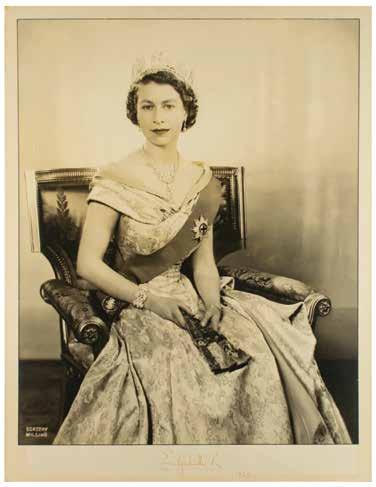
Marvelous oversized portrait, by royal photographer Dorothy Wilding
33. Queen Elizabeth II Signed Photograph. Resplendent oversized matte-finish 18.75 x 23.25 portrait of Queen Elizabeth II seated and wearing her glimmering crown jewels by Royal Court photographer Dorothy Wilding, affixed to its original 20.25 x 26 studio mount, neatly signed on the mount in fountain pen, “Elizabeth R, 1953.” Reverse of the mount bears Wilding’s studio label, which is numbered in pencil: “015957, J.” In fine condition, with some light toning from prior display. An absolutely stunning portrait of the queen—the largest that we have ever offered. Starting Bid $200

